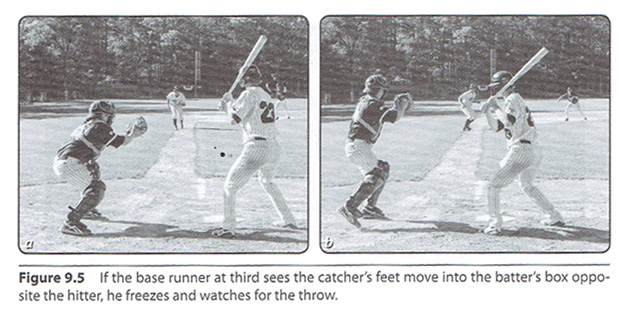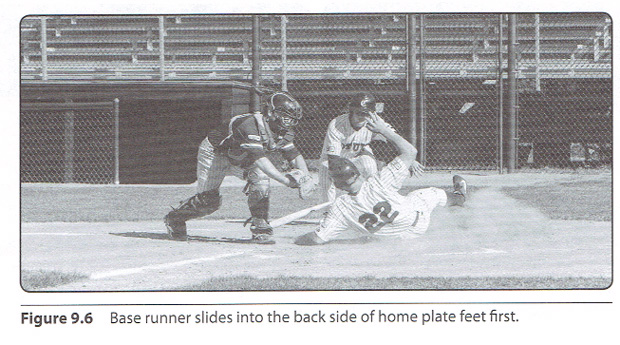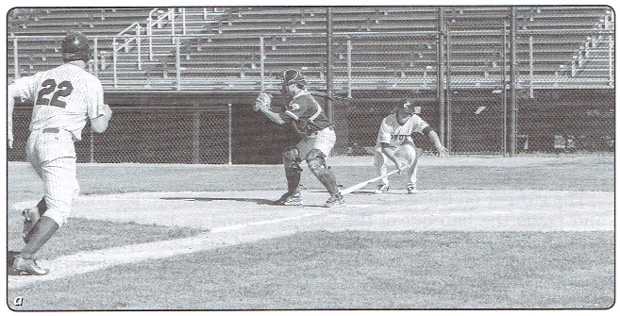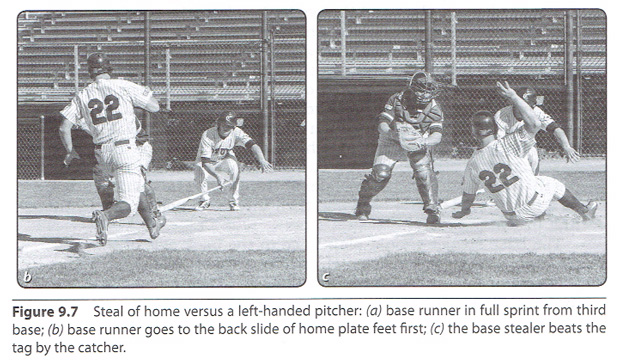| Stealing Home With Runners on Third and First |
| By: Mike Roberts
Originally Published in: Baserunning - Provided by: Human Kinetics Double steals are covered in detail in chapter 10, but here I do want to lay out what the runner at third base does to steal home with a runner moving from first base. With runners on third and first, several plays allow the runner at third a good opportunity to steal home. Reaction Versus a Right-Handed Pitcher When the runner at first base is moving on a delayed steal, the runner at third should watch the catcher's feet to see if a pitchout is on. If the catcher's feet move into the batter's box opposite the hitter (see figure 9.5), this freezes the runner at third base and makes it difficult for him to score, even if the catcher throws to second base. The runner at third base also has to be aware that the catcher is in a good position to throw directly at him to make a pickoff attempt. If there is no pitchout, the runner can meander down the third-base line but must remain aware that the throw can go to second base, the pitcher, or third base or the catcher may fake a throw. This is why it is so important to anticipate what the defense might do but even more important to read what actually happens with the baseball.
Anticipating the steal home with runners on third and first should be practiced often since this setup happens many times during the course of a season. The runner at third base should read the throw to have the opportunity to steal home. The only throw that gives the runner at third base the opportunity to steal home is one over the pitcher's mound heading toward second base. The runner at third base first reads the ball out of the pitcher's hand and then turns his attention to the catcher. Initially the runner reads the catcher's feet. If the catcher stays behind the hitter to catch the baseball and acts like he is making a throw toward second base, the runner should have anticipated this throw, read the flight, and have started controlled steps toward home plate. As the ball leaves the catcher's hand, the runner reads the angle of the ball toward second base. Is the ball thrown very flat like an old clothes line, or does it arc like a rainbow? If the flight of the ball is very flat, it is more difficult to attain a great jump to steal home. The runner needs to make sure the pitcher does not cut off the ball as it carries past the mound, so this may freeze the runner for a split second. Plus, a low throw usually has great velocity and reaches the shortstop or second baseman quickly, which allows a return throw to the plate sooner if the runner on third attempts to steal home. However, if the flight of the ball arcs, it makes it less challenging to steal home safely. Since the throw is higher and normally of average velocity, the runner is able to get a better jump. If the runner feels he has a good lead as the ball leaves the catcher's hand in an arc toward second base, he can break for the plate and attempt to steal. The runner should anticipate sliding to the back side of the plate, preferably feet first (see figure 9.6). A runner who decides to slide head first should be sure to go around, not through, the catcher in his attempt to tag home plate.
Reaction Versus a Left-Handed Pitcher With a left-handed pitcher holding runners at third and first base, the runner at third has a much greater chance of stealing home. Since the left-handed pitcher's back is to the runner on third base, the runner can take a larger initial lead, as much as 18 to 21 feet (5.5-6.4 m). The runner on first base takes a lead or attempts to steal to draw a throw and set up the potential steal of home by the runner on third. The runner on third anticipates the pitcher's front leg coming up and reads the ball out of the pitcher's hand as he throws to first base. Before the pitcher moves any part of his body, the runner on third walks into a lead that takes him 25 to 28 feet (7.6-8.5 m) from third base. As the pitcher's foot leaves the ground, the runner on third begins to sprint toward home plate. If the pitcher rotates the foot toward home plate and throws to the plate, the runner breaks and busts it back to third base. The lead is so great that the runner cannot stand in the baseline and wait to see if the hitter makes contact because if the ball lands in the catcher's mitt the runner has a decent chance of being picked off if the catcher throws to third. If the pitcher picks up the foot and the throw goes to first base, the runner at third base is already in a dead sprint to the plate (figure 9.7). Sometimes the pitcher will throw the ball on a line to the first baseman, and other times the ball has a rainbow arc. Either way the throw is made, the base stealer at third is in a race with the ball as it is delivered to first base and then thrown to home plate by the first baseman. The base stealer should plan to go to the back side of the base, preferably feet first. A runner who decides to go head first should go around the catcher and try to tag home plate from the back side to avoid a collision because it's almost always a bang-bang play. |










